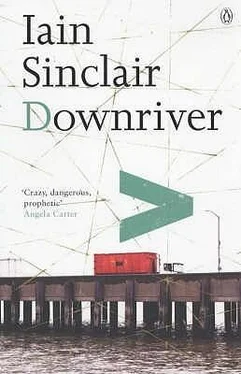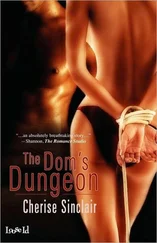‘It’s bad karma to watch people sleeping,’ Imar frowned. ‘Better to put your eye to the keyhole and watch them fuck. It’s especially bad to watch a pregnant woman sleep. That’s taboo. The whole quality of the experience is so intense.’
‘No, no, no,’ Sonny yelped, ‘I want the heroic side. People taking action for themselves, capturing their own space; taking their destiny, forcibly , into their own hands. That blitzed community of sleepers, dreaming their archetypal dreams, recapturing previously excommunicated territory — railway tunnels, sewers, bridges. Photographs by Bill Brandt evoking communal memories: lovers nestling against each other… the face of an old hag in the crypt of Christ Church, Spitalfields… timeless!.. she could have known the Ripper. Or those orthodox Jewish fathers in the Brick Lane shelter. The dignity! Undisturbed, carrying on their work, Books of the Law. What Brandt does… here, look.’
He shoved a photograph towards Imar.
‘What? A shed of gassed chickens?’ I mar responded. ‘Mouths agape, toothless, arms flung out — they are nothing but victims.’
‘I see the shelters,’ Sonny persisted, ‘as a “concrete armada”. This is one of the highs of our history, a time for the people, and we’ve got to link it with what you’re doing now — not with the madness of Crosby’s Tower of Babel.’
If the Silbury Mound field was a strong, though imperceptible, public statement, then the Bracken House bunker was one of the most notable single-handed achievements I have ever encountered. Imar, in the guise of a remedial gardener, had been granted access to a stark exercise yard, imprisoned on three sides by tall blocks of windows. Every move he made was viewed by the other tenants; and yet his master plan went unremarked, if not exactly a state secret.
Beneath the grass-flecked clay of this sombre garden was the formal geometry of a wartime bunker, harmoniously divided into four self-contained chambers. Platonic truths had been reasserted in these gnomon -activating depths: invisible passages between the world of elements and the race of life. Imar had excavated the entrances, one by one; had listened carefully to the oracle of falling water. He waited for clusters of eolithic light to break from the tainted darkness.
We sat on a log at the bunker’s edge and let the night swallow us: solitary windows flared, glimpses of movement, opera snatches muffled in rapidly drawn curtains. This welfare rookery had fallen into the hands of the only people prepared to relish a Soviet-style glamour: students, archivists, state-sponsored artists. A gibbous moon slid from its cloud cover, offering — in the unwalled southern sector — a carnival vision of the most outflung of the Docklands studio-bivouacs; a pointless flurry of trapped waves, portholes and marine quotations. A pleasure boat grounded one nautical mile from the river.
It was time to go under. We slid our spades beneath the squares of turf that Imar designated, and dug — until we heard the clink of metal upon metal. A trapdoor was located, prised open, lifted. We lowered ourselves, feet scrambling for the rungs of a ladder, into the clammy darkness. We advanced, hesitantly, inch by inch, through unconvinced puddles of light afforded by my pocket torch. We found ourselves, at last, inspecting an icehouse, in which time itself had been chilled, slowed, handicapped. Even in the breath of our heightened expectations, the bunker remained obstinately less than it was.
The antechamber was steepled so high with industrial fallout that the only entry to the inner sanctum (the heart shrine) was by way of an obstacle course, perilous enough to deter any respectably mercenary tomb robbers. ‘I let an old rag and bone man stash his stuff,’ said Imar. ‘He asked if he could leave a couple of things here — just for a few days: then came back with a pantechnicon.’ What was on offer? Washing machines so ancient they must have been pedal-driven; useless slices of bicycle; sodden briquettes of paperbacks, congealed into twelve-deckers; enough folding chairs to sit out a square dance; Marcos-rivalling collections of single shoes; artificial limbs for dogs; gas stoves; lavatory bowls; columns of rusting paint tins: a fully-stocked museum of folk memories. We picked our way, admiringly, among the exhibits. And, as we stumbled blindly forward, we snapped off the spears of occasional stalactites; limey droplets plicked irregularly on to the flooded tile floor. In the torchlight the low ceiling shone like a dome of radium-licking insects (about to become stars). An eidetic cinema.
The secret inner chamber had been successfully dammed, mopped, dried, polished. The walls had been scoured of bureaucratic symbols and the blood oaths of cadet gangsters. The chimney pipe had been cleared of dirt, dead birds, rags: it was possible, once more, to light a fire. ‘You should see them heave shut their curtains, when they see smoke rising, without apparent cause, from the old grass hump,’ said Imar. ‘Legends are spreading. Civilians keep well clear. They think some berserker mob are incinerating inconvenient human evidence.’
Oozing goodwill, and cackling with pleasure at his own strategies. Imar was no ‘divine light’ zombie: his vision could have been realized only through an immensely powerful self-belief (and many man-hours of vein-popping muscular effort).
‘I determined, when I first heard rumours of this heretical Silvertown monument,’ he announced, ‘to counter it with one of my own. To work faster than they could work. To start digging while they were still farting around with brochures and flogging the circuit of merchant banks. Look at the blasphemy of it.’ He jabbed fiercely against a projection of Crosby’s river, pinning it to the wall; then swept an avenger’s hand over this plucky attempt to align such reservoirs of the eternal spirit as the Museum of Design, Tower Bridge, and HMS Belfast .
‘Can you believe it?’ he stormed on. ‘These people want to erect their obscene stack, a heap of inert and spiteful weaponry, upon the most potent site on the aetheric highway between Greenwich Hospital and St Paul’s Cathedral. They actually intend to deflect the path of light, opened and acknowledged by Nicholas Hawksmoor; the ley that runs down from Blackheath — without drama or fuss — exactly through the gap between the twin domes, across the river, over the malign Isle of Dogs, to circle and recharge at the Tower of St Anne, Limehouse. As the light travels, it fades from our sight, but its influence does not pale: the Jews’ Burial ground, Whitechapel… King Cole’s eucalyptus, the caterpillar dreaming tree, Meath Gardens… Victoria Park fountain… Well Street. It blesses and touches all those unacknowledged and marvel-provoking enclosures; a spine of hope. How dare Crosby misread Turner’s “View of St Paul’s from Greenwich” (the Maze Hill eidolon)? Turner is careful to place an antlered deer in the foreground, and also a buck — so insubstantial that you can see the canvas beneath. These are the animal familiars, the spirit guides. Turner must never be dragooned into the enemy’s camp.’
Sonny’s frustration at not being able to take notes in the dark, and not knowing what the hell Imar was talking about, made him pathetically eager to escape our confinement. A smothering, claustrophobic sense of being ‘out of it’, beyond telephones — perhaps for ever — contributed to his unease. He was now quite certain that if we ever should re-emerge into the real world, there would be nothing left . The flats would be a cliff of termites, and the wasteland a robot-controlled industrial estate. Even his beloved Bow Quarter would have regressed to supplying matches to a phantom army of beggar girls. Surely, that was impossible. The Bow Quarter would never fail. But Imar’s voice had that quality: an undertow of mad humour that threatened to freeze into uncensored prophecy. He laughed aloud as he savaged Crosby’s demonology of bad faith.
Читать дальше












